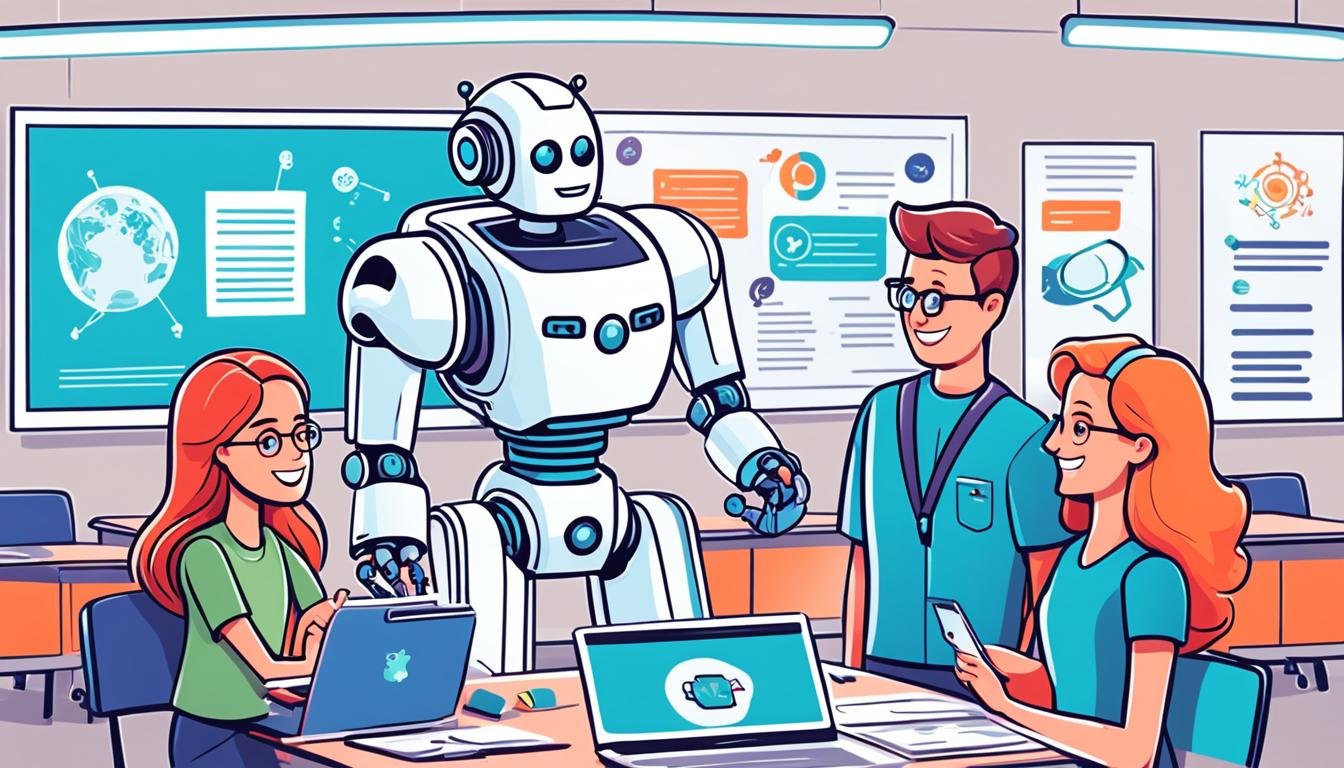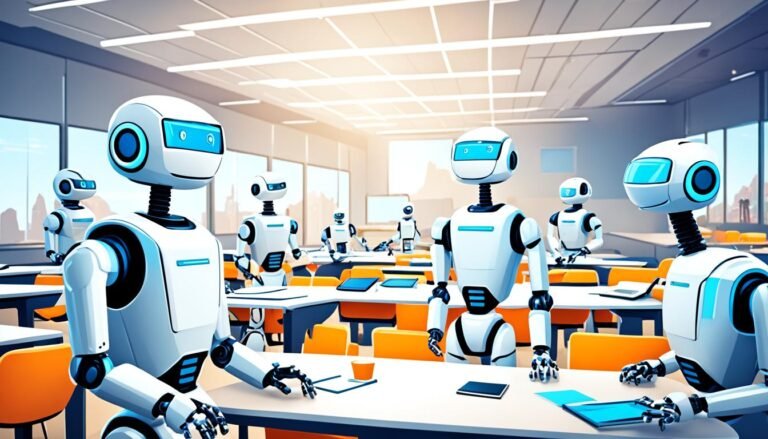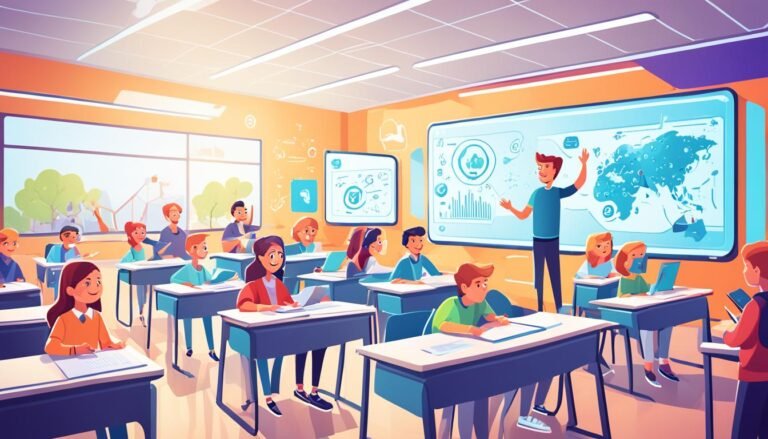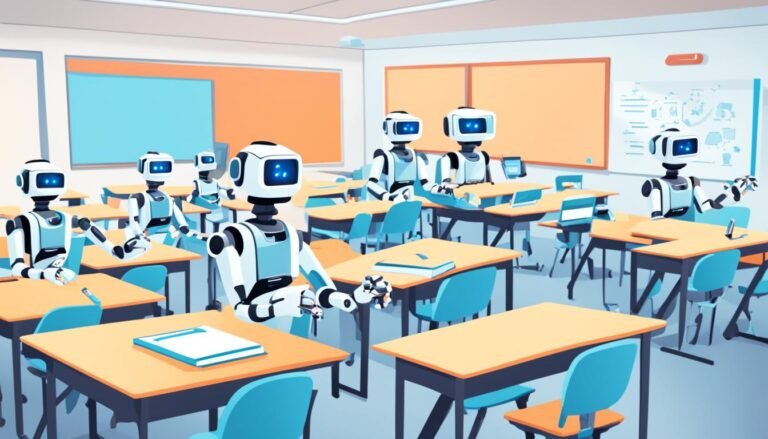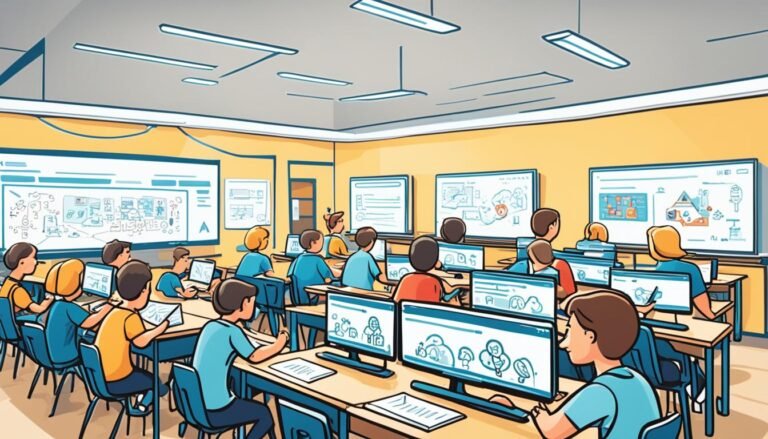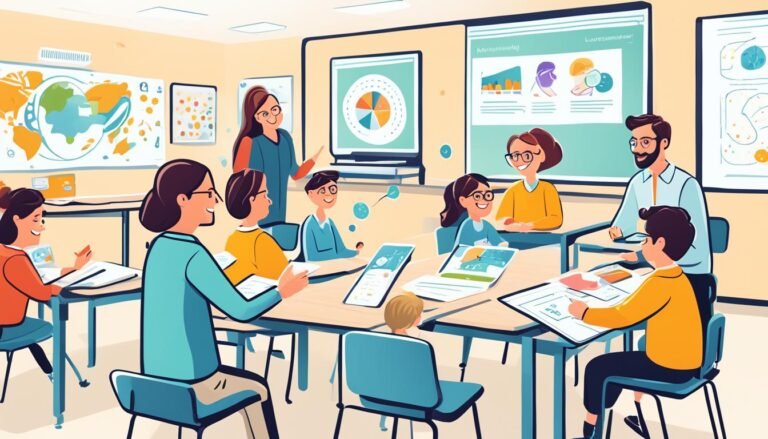AI in Education: Future Trends and Innovations
One cold day in early 2023, Ms. Johnson, a teacher from New York City, had a time problem. She found it hard to manage her time with lesson plans, grading, and helping students. She wanted to teach in new ways but wasn’t sure how, especially for students who needed extra care. Then, she learned about using Artificial Intelligence (AI) in her classroom at a seminar. She found out that AI tools could change everything.
By 2024-2025, AI is going to make big changes in schools. These AI tools use powerful neural networks and need lots of data to work. But, they will make learning better in many ways. For example, students can now get help instantly with AI tutors online, just like they would from real teachers.
AI tools offer a chance to give great education to more people, even in faraway places. But, there are some big concerns to think about. Things like keeping student data safe, making sure the AI is fair, and not relying too much on technology are very important. Teachers, including Ms. Johnson, need to be careful when using AI in their classrooms.
New and fun ways to learn are coming soon. Through Natural Language Processing (NLP) and Augmented Reality (AR), learning will be more hands-on and exciting. This means every student can get lessons that fit them perfectly, making learning more personal.
TeachAI is helping teachers use AI the right way. In 2023, many teachers wanted to learn more about AI. Next year, we expect more schools and districts to give teachers the help they need.
Key Takeaways
- By 2024–2025, generative AI is expected to significantly impact education, enhancing learning experiences and administrative tasks.
- Generative AI tools rely on complex neural networks like transformers and require extensive datasets for effective training.
- AI-powered virtual tutors provide on-demand help, closely mimicking human tutoring interactions.
- AI tools can broaden access to quality education, particularly in remote and underserved regions, enhancing student engagement and operational efficiency.
- Despite immense possibilities, the implementation of generative AI in education faces challenges like data privacy concerns, potential biases, and increased technology dependence.
Introduction to AI in Education
AI is changing the way people learn, making big changes for teachers and students all over. More than 60 experts from top universities in China, the USA, and Finland have added to what we know about AI in education. They show its huge importance all around the globe.
The European Commission points out how important AI is for making good things happen in society. In the USA, the National AI Initiative Act of 2020 wants to push AI research forward quickly, which can help the economy and keep the country safe. These steps show how much impact AI has on our world and its future.
The OECD and the UN tell us just how powerfully AI is changing things in all areas, including education. The UN, through a Resource Guide on AI Strategies, and UNESCO’s recommendations, show the path for using AI in a fair, ethical way. It’s all about making sure AI helps every student in a good way.
Intelligent tutoring and personalized learning systems are changing the way we teach and learn. These tools are making learning better, not just in colleges but also in how teachers work with students. They make things more efficient, like how people get in, learn, stay, and stay safe at school.
But, there are big questions about using AI in education, like keeping data safe and preventing bias. Schools and companies need clear rules to handle these issues. Companies using AI are breaking down complicated data and making learning tailor-made. This helps find where students need more help and makes learning more personal, fun, and better.
AI is about way more than just making things run smoother at schools. It helps schools make the best use of resources, learn smarter, create smart lessons, and do quick checks on learning. This all makes learning a place for everyone, no matter the challenge. The future of education with AI looks promising, making learning more flexible, fun, and available. This is thanks to more and better AI tools and ways of doing things.
Supporting Teachers through AI Augmentation
AI Augmentation opens up great chances to make education better. It helps solve problems teachers face. In schools, more and more AI systems are used, making tasks easier and giving key help.
Freeing Time for Teachers
AI Augmentation is great at helping teachers manage their time. It lets them leave admin stuff to machines and focus on kids.
This means teachers can spend more time talking to students. AI looks at student plans, suggests changes, and even warns if something needs doing. For example, AI turns what students say into text for their essays. It can also change text into spoken words for feedback, cutting down on boring jobs.
- Automation of attendance tracking
- Grading assignments
- Providing real-time feedback on student performance
Enhancing Teacher-Student Interactions
AI makes it easier for teachers to know how well their students are doing. It provides tips to make learning better for each student.
Merlyn Mind Practitioner Advisory Board teachers say AI helps a lot with students who have special learning plans. It gives teachers advice on how to change these plans to help students the best. This makes teaching more personal and effective.
AI also checks on student plans and suggests extra help they might need. This takes some work off the teachers. AI writes up the changes made for families to read. But teachers must check this work to make sure it’s right.
Balancing Support and Oversight
Although AI tools are good for teachers’ time and learning outcomes, they bring new issues. Keeping student info safe and making sure AI is fair and equal is important. Teachers must watch over AI to be sure it’s helping students learn well.
In short, AI makes teachers’ jobs easier and improves teaching by using data and helping students individually. This mix makes education more alive and effective.
Personalized Learning through AI
As tech becomes more common in schools, Personalized Learning AI becomes key. With *AI-powered learning tools*, teachers can make each student’s learning unique. This way, learning fits their special needs, likes, and how they learn best.
Adaptive Learning Systems
Adaptive Learning Systems use smart math to watch how well a student is doing. They change what and how they learn to fit each student. Systems like Knewton and DreamBox make sure students are learning just what they need. This makes learning better for them and also more fun.
AI tools, like Choice Texts, are changing classrooms for the better. This reading tool lets students pick what they read. It makes reading more fun by giving them stories that interest them.
Personalized Tutoring
Tutoring with AI, like on Duolingo, acts just like having a private teacher. It changes the lessons to fit how well the student knows the subject and how fast they learn. This kind of learning has been shown to get students better grades.
Personalized AI learning helps students grow and do well in school. It makes learning fun and matched to what they need. Because of this, students like learning more and feel more confident in their schoolwork.
| AI Tool | Purpose | Benefits |
|---|---|---|
| Choice Texts | AI-powered reading tool | Customizable reading passages and questions, fosters engagement |
| Knewton | Adaptive learning platform | Real-time performance assessment, customized lessons |
| Duolingo | Language learning platform | Personalized lessons based on proficiency and pace |
| DreamBox | Intelligent tutoring system | Personalized guidance and support, adaptive learning pathways |
AI-Powered Assessment and Analytics
The way we teach is changing fast with AI tools. The market for these techs could hit $23.82 billion by 2023. Schools and teachers use them to improve how students learn.
Automated Graded Assessments
These AI systems check student work quickly. They give detailed feedback instantly. This helps teachers change their lessons fast, saving time and keeping grading fair.
A 2023 survey by Forbes Advisor found over half of US teachers liked AI in schools. They found AI tests helpful. These tools can even understand long answers, finding new info that traditional tests might miss.
Real-Time Performance Analysis
Real-time stats show how well students are doing. This lets teachers see what each student needs right away. It makes lessons fit each student better. Tools in AR and VR can watch eye movements and more to help understand students.
The AI in schools market could grow 38% each year from 2023 to 2030. Now, over 60% of teachers worldwide use AI in class. These smart tools make learning better for everyone.
| Year | Market Value (in billion $) | Growth Rate (CAGR) |
|---|---|---|
| 2023 | 23.82 | 38% |
| 2030 | Projected Increase | 38% |
Machine learning is making education smarter and more personal. It’s not just about tests and stats. It’s changing how we learn for the better.
AI Literacy for Students and Educators
AI is now present in many parts of our lives. So, it’s key to teach AI knowledge in schools. This way, both students and teachers can be ready for a world driven by AI.
AI Skills for Future Job Markets
Teaching students about AI means focusing on important topics. These include machine learning, neural networks, and algorithms. AI literacy is crucial for many jobs. By 2024, 89% of IT leaders think AI will be key in their jobs. Training in data skills, coding, and AI tools will make students more employable.
Students with AI knowledge can think creatively and solve tough problems. They should also learn about using AI ethically. This way, they’re ready for future jobs and are responsible global citizens.
Training Educators on AI Tools
Educators need to learn about AI to teach it well. Still, most teachers haven’t had official training on AI. Sites like Go2Knowledge and StudentLingo offer courses to help teachers catch up.
Teaching teachers about AI helps them share this knowledge with their students. Leaders at the district level can also make sure AI is used safely and well. This can help prepare all students for a future where AI is everywhere.
Innovations in Virtual Learning Environments
In education, Smart Classroom Solutions and technologies like Virtual Reality (VR) and Augmented Reality (AR) are advancing. They provide interactive, hands-on learning, meeting each student’s needs and style.
AI in Smart Classrooms
AI lets Smart Classroom Solutions offer personalized learning. It uses student data to adjust teaching, improving engagement and results. This approach allows educators to provide tailored support and optimize learning with deep insights.
Virtual Reality and Augmented Reality in Education
VR and AR turn traditional learning into an active, engaging experience. Students can virtually explore various topics, from past events to scientific experiments, to learn deeply and remember more. Yet, their use faces issues such as high costs and privacy worries.
“VR technology creates immersive learning where students interact with complex concepts hands-on.” – Educational Technology Research
To make AI and VR work in education, knowing their benefits and challenges is key. It’s essential to explore new tools, measure their effects, and work with tech experts. Plus, ensuring all students can access these tools fairly is critical to avoid a digital gap.
| Challenges | Solutions |
|---|---|
| High Technology Costs | Investment in Affordable Infrastructure |
| Privacy and Security Concerns | Use of Secure Platforms and Encryption |
| Lack of Trained Personnel | Training and Collaboration with Experts |
| Digital Divide | Ensuring Equal Access for All Students |
In conclusion, combining AI and VR with Smart Classroom Solutions improves the online learning experience. Tackling obstacles and using these technologies rightly, educators can develop a better, more engaging way to learn.
Future Trends and Innovations in AI for Education
AI is making learning better and more exciting in schools. The World Economic Forum talks about Education 4.0, saying we need new ways to teach because of technology growing so fast. AI that creates things and makes learning like games is very important now.
Generative AI in Education
Generative AI is changing how education materials are made and shared. With AI, lessons can be more about what you like and how you learn. For instance, it can make study guides that fit just you. Studies show this kind of help from AI makes students do better than almost all other students.
AI-Powered Gamification
Using games and AI together makes learning fun and helps you want to learn more. These can be serious about learning but also fun and full of rewards. With games, students get to see their progress quickly and always get new challenges at the right levels. This helps them learn steadily and well.
AI-enabled assessments offer educators invaluable insights, from pinpointing learning trends to supporting the evaluation of non-standardized tests.
Education’s future is with AI, making us better at using technology and thinking well. As AI that makes things and games for learning gets better, school will be more fun and just for you.
| Trends and Innovations | Benefits |
|---|---|
| Generative AI | Personalized content, enhanced engagement, and better learning outcomes |
| AI-Powered Gamification | Adaptive learning challenges, increased motivation, continuous assessment |
Ensuring Equity with AI in Education
Artificial intelligence (AI) is changing education for the better. But, we must make sure it helps every student, without making existing problems worse. The U.S. Department of Education highlights the need to fill in the learning and access gaps with technology. We can do this by sticking to the Digital Equity Framework. This approach focuses on leadership, systematic planning, access to devices, digital skills, and using tech for better learning.
AI for Inclusive Learning
AI helps make learning fit for everyone, no matter the need or style. Educators have seen great results with AI tools like DreamBox Learning and Duolingo for students with special needs. These tools create a learning path just for them. They help by offering different ways to learn and teach, making lessons more inclusive.
But there are downsides like biased AI that might treat students of color unfairly. To deal with this, we must take a big-picture approach suggested by Digital Promise. This means checking AI regularly, setting strong guidelines, and teaching about AI in the curriculum. Joining in advocacy and research can also spread good, fair uses of AI in education.
Also, making sure everyone can access and use these tech tools is key to being fair. Platforms like HiMama and Socratic by Google show how great AI can be when everyone can use it. Schools need to have good tech and teach teachers how to use it well. This way, AI can make learning fair and good for all.
Source Links
- Generative AI In Education: Key Tools And Trends For 2024-2025
- 7 Artificial Intelligence Trends That Could Reshape Education in 2024
- How technology is reinventing K-12 education
- Introduction to AI in Learning: Designing the Future
- AI in Education: Transforming Teaching and Learning
- Everything you need to know about AI in education
- Teachers Partnering with Artificial Intelligence: Augmentation and Automation – Digital Promise
- The Role of Artificial Intelligence in Global Education: Bridging the Learning Gap
- 7 AI Tools That Help Teachers Work More Efficiently
- AI and the Future of Personalized Education
- The Future of AI in Education: Personalized Learning and Beyond
- Personalized Learning: How AI Is Shaping the Future of Education
- 6 AI Trends That Will Transform EdTech in 2024
- AI in Education: Benefits, Use Cases, Challenges, Cost & More
- Learning With AI, Learning About AI
- AI Literacy Essentials For Students: Preparing For The Future
- Developing K–12 AI Literacy for Your District
- Embracing the future of Artificial Intelligence in the classroom: the relevance of AI literacy, prompt engineering, and critical thinking in modern education – International Journal of Educational Technology in Higher Education
- Evolving Education: The Impact Of AI And VR Technology On The Future Of Learning
- Future Trends in AI Personalized Learning
- The Future of Education: Innovations and Trends Shaping the Learning Landscape
- The future of learning: AI is revolutionizing education 4.0
- Five AI Trends Shaping the Future of Education
- The Future of Education: How Artificial Intelligence is Transforming Learning
- How AI for Education Can Address Digital Equity – Digital Promise
- How to ensure education equity in the age of AI
- The Future of Education: How Artificial Intelligence is Transforming Learning

